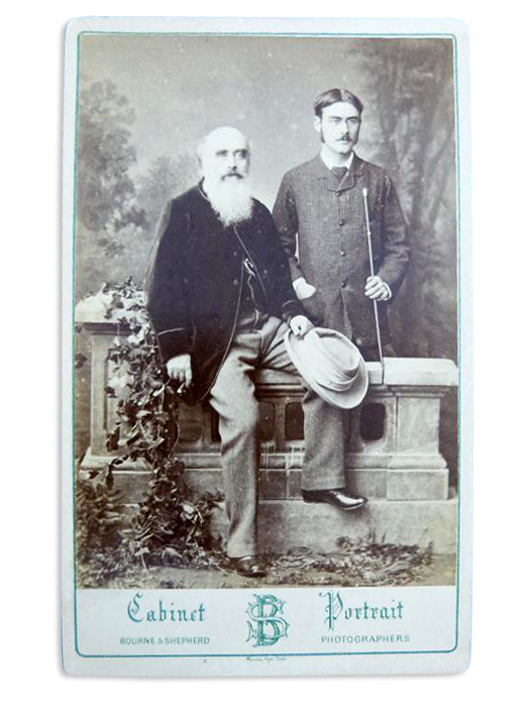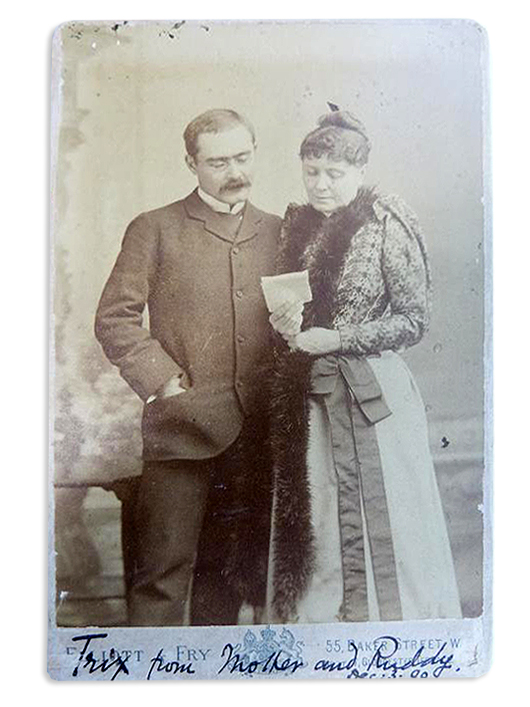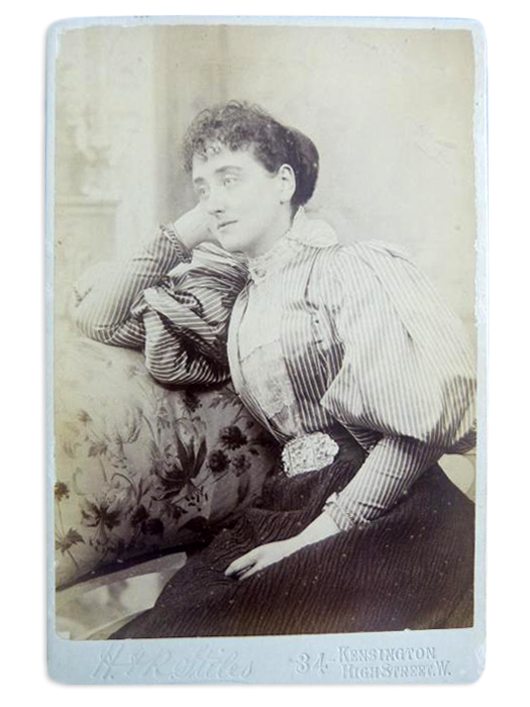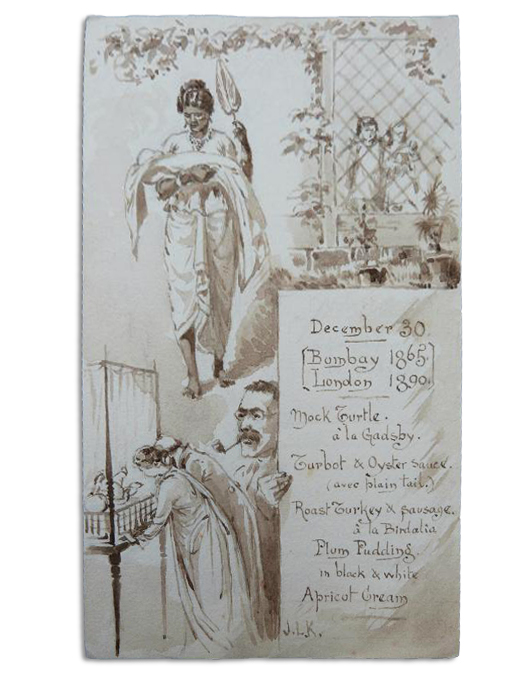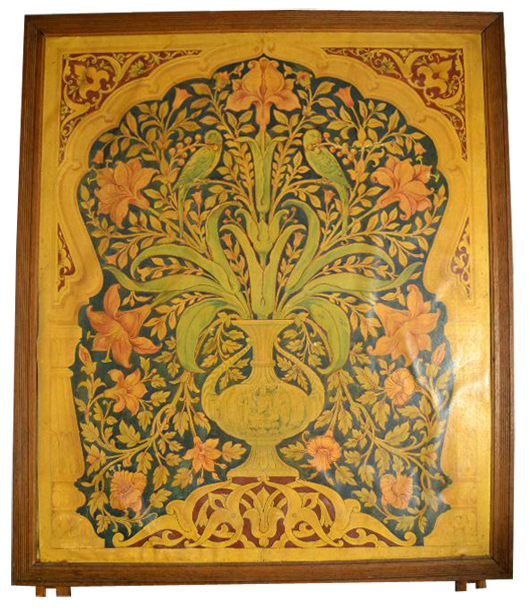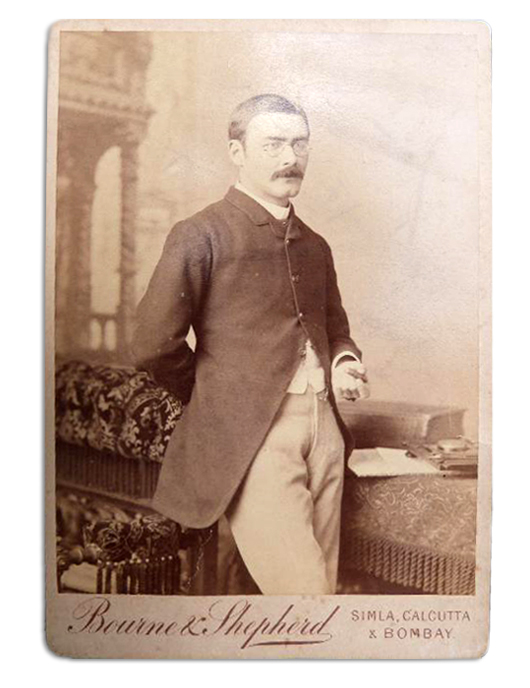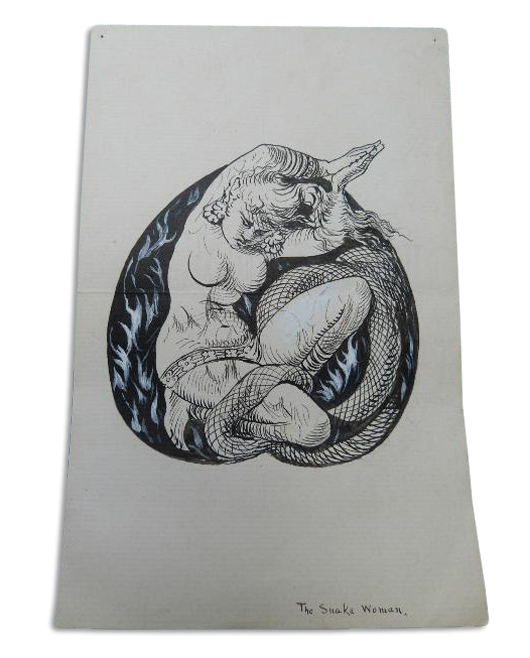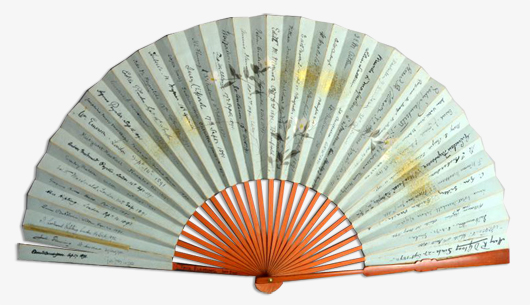
Rudyard Kipling with his father, John Lockwood Kipling. Ewbank’s image.
SURREY, UK – A unique family collection of Rudyard Kipling letters, photographs and personal items, some of them belonging to the author’s troubled “forgotten sister,” is to be sold by Ewbank’s. The archive is expected to excite Kipling scholars around the world and will be offered on the second of the auctioneer’s two-day summer sale, which is on June 25-26.
LiveAuctioneers.com will provide Internet live bidding.
The collection of around 90 lots, much of it previously unseen, was inherited by Helen MacDonald, great niece of Kipling’s mother Alice MacDonald, about whom a future Viceroy of India would say “Dullness and Mrs. Kipling cannot exist in the same room.”
Alice married Kipling’s father, John Lockwood Kipling, and moved to India in 1865. Her three sisters married respectively the artists Edward Burne-Jones and Edward Poynter and Alfred Baldwin, father of Prime Minister Stanley Baldwin. From Helen MacDonald, Rudyard Kipling’s first cousin once removed, the archive passed by gift to the present consignor.
Most poignant is an autograph letter to Kipling’s brother-in-law John Fleming about Kipling’s sister, Alice “Trix” – herself a published novelist, being certified insane.
Kipling and Trix were both born in India but his days of “strong light and darkness” in Bombay ended when, following the custom in British India, at the age of 5, he and his 3-year-old sister were sent to England. They lived unhappily with a foster couple in Southsea, who boarded children of British nationals serving in India.
Written on paper from “Hotel du Parc & sa dependance Hotel Ibrahim Pacha” in the French Pyrenees, on March 13 1911, Kipling notes that the objection to Trix being certified is sentimental, “but none the less jars on me.”
“One must remember that the attack has now lasted barely three months and it has been taken in hand practically from the first, so one can begin to hope that another few weeks may see the turn in the malady. At any rate the fact that she regards the nurse as she does is proof, at least, that she is in sympathetic hands. What her demeanour may be to her family and surroundings is a matter that may depend on a hundred causes to which, in a short visit, one has no clue. It is to be remembered that in the overwhelming number of mental cases they turn for a while against those who are nearest to them. Our weather is rather cold with a falsely blue sky.”
The letter is estimated at £300-500, as is Trix’s folding paper fan, which she used like an autograph album. It dates from 1891-1895 and is signed in ink by Rudyard Kipling, Stanley Baldwin, Edward Burne-Jones and his wife Georgiana and Edward Poynter.
A hint of the darker side of Trix’s mind is offered by her black-painted gilt decorated box, decorated by her father, John Lockwood Kipling, containing her fortune-telling paraphernalia comprising her crystal ball and a copy of Cheiro’s Palmistry For All, containing “New information on the study of the hand never before published,” inscribed to Alice Fleming (her married name) from “Linda”. It is estimated at £200-300. It has been suggested that Trix’s interest in fortune telling may have led in part to her unsettled mind.
According to Mary Hamer, author of Kipling & Trix, published in 2012, Trix experimented with “automatic writing,” an activity associated with spiritualism. She writes: “Trix would sit at her desk, pencil in hand, notebook at the ready, and wait. Her hand, she reported to friends, would start moving of its own volition, scribbling over the page.”
She subsequently sent copies of the messages back to the Society for Psychical Research in London, where they were taken extremely seriously. Her “spirit-writings” were collected as part of a group experiment, known as the “cross-correspondences.” Under the pseudonym of ‘Mrs. Holland’ she became a celebrated spiritualist medium.
“Rudyard warned his sister to keep clear of spirit writing, well aware that it had been known to cause breakdowns. But it was too important to her. She persisted. And duly broke down, in 1898 and again for a long period starting in 1911, when her mother died,” Mary Hamer writes.
Living later in Edinburgh, she would make visits to the zoo there, making her way from cage to cage, talking to the animals in the Hindustani language she learned as a young child. Her notebook filled with the words and phrases she used is estimated at £100-200.
Trix’s heart-shaped silver brooch inlaid with green and clear paste stones, passed down to her by her mother, is accompanied by a note in Trix’s hand giving it to the Macdonald sisters It is estimated at £30-50.
Other, more valuable, jewelry in the archive may have either belonged to Trix or was bequeathed to her, but this cannot be confirmed. Diamond rings of three and five stones are estimated respectively at £1,000-1,500 and £800-1,200, while a Victorian diamond flower brooch has retained its original retailer’s box, which is marked Carter’s of Bombay and Poona. This was almost certainly owned originally by Trix’s mother and is estimated at £600-800.
John Lockwood Kipling was himself an accomplished artist, illustrating many of his son Rudyard’s books. The archive includes a panel hand-painted by Lockwood Kipling depicting a vase of flowers and birds among scrolling foliage. It is referred to on Page 383 of Trix, Kipling’s Forgotten Sister by Lorna Lee, the caption reading: “The decorative panel (varnished paper) by Lockwood which Trix used as a firescreen. Trix always wanted this and it was collected from “The Gables” at Tisbury by Jack Fleming (Trix’s husband ) after Lockwood’s death.” It must subsequently have passed to Helen MacDonald when Trix died and is estimated at £100-200.
Two pen and ink drawings by Lockwood Kipling titled respectively The Ruby Prince showing a man surrounded by cobras, signed with initials, the other The Snake Woman, each measuring 7 inches by 4 1/2 inches, are together estimated at £50-100.
A hand-decorated and written menu in pen and wash celebrating Rudyard Kipling’s 25th birthday on Dec. 30 1890 depicts him and other figures and is signed with his father’s initials JLK, while the reverse bears Rudyard Kipling’s own ink design. It measures 9 inches by 5 1/2 inches and is estimated at £100-150.
An autograph letter from Kipling to Trix dated Dec. 15, 1935 is on four sides of headed paper from Bateman’s in Burwash, Sussex, the Jacobean house where Kipling and his wife, Carrie, lived from 1902, now belonging to the National Trust. Kipling used the house and its setting for many of his stories in Puck of Pook’s Hill (1906) and the sequel Rewards and Fairies (1910).
Addressed: “Ho! daughter of my mother,” the letter reads:
“Im busy clearing up odds and ends as behoves one whose 70th birthday is upon him! I accept it but I can only say that I don’t feel in the least like it, nor do I like it in the least.”
There are references to his first cousin, Stanley Baldwin, and the League of Nations and to having recently met Neville Chamberlain: “he seemed quite calm which I confess I am not in respect of Italian possibilities. Its a vindictive people with long memory.” The letter and its envelope are estimated at £100-150.
In a report on an exhibition at The Elms, Rottingdean, Kipling’s seaside home near Brighton from 1897-1902, The Kipling Society’s Journal of 1951 refers to “the intriguing – and somewhat eerie Max Desmarets” whose Valentine written by Kipling on Feb. 14, 1884 was exhibited. The journal notes the Valentine was written while Kipling was in India in tiny handwriting on a small folded gilt-edged card illustrated by him in red ink and opening with the couplet: “How shall a ghost from Père la Chaise Greeting send to a vanquished love?” “… but who Max Desmarets was and how he drifted into R.K.’s ken – or imagination – no one knows. This exhibit also had previously never been published or shown.”
The sale includes what is believed to be the actual valentine, written and illustrated by Kipling on two pieces of gilt-edged card and is almost certainly that referred to in the exhibition. It is estimated at £200-300. Interestingly, an edition of the Allahabad Pioneer (for which Kipling was later to work) dated Jan. 2 1884, states that Kipling took the part of M. Desmarets in an amateur performance of Plot and Panion at the Railway Theatre in Lahore. This would have been during the time he worked on the Lahore newspaper, the Civil and Military Gazette, after he returned to India in 1882.
In 1883, Kipling visited Shimla (then known as Simla), a well-known hill station and the summer capital of British India. Kipling returned there for his annual leave each year from 1885 to 1888, and the town figured prominently in many of the stories he wrote for the Gazette.
A handwritten poem signed and dated “Rudyard Kipling Simla 1885, June 2nd 1885” is estimated at £200-300.
The archive contains many photographs, some previously unseen, including two from the Simla studio of Bourne & Shepherd, Simla, Calcutta and Bombay.
A head-and-shoulders cabinet photograph is autographed and inscribed “Yours very sincerely Rudyard Kipling,”’ inscribed verso “A kind of scrubbed boy – a lawyer’s clerk’ (Merchant of Venice). The photograph is estimated at £200-300, while a three-quarter length cabinet photograph from the same studio is estimated at £100-150.
A cabinet photograph depicting Kipling and his mother is dated “Dec 13. 90,” and is dedicated to his sister: “Trix from Mother and Ruddy.” By Elliott and Fry Photographers, 55 Baker Street, London, it is estimated at £200-300, while another depicting Kipling and his father, John Lockwood Kipling, by Bourne & Shepherd, is estimated at £100-150.
Two silver gelatin photographs of Kipling when he was young, one with shoulder-length hair and wearing a sailor’s uniform, the other with short hair wearing a jacket and bow tie are together estimated at £80-120, while two albums and numerous loose photographs relating to the Kipling and MacDonald families, many of which can be found throughout the book Trix: Kipling’s Forgotten Sister are estimated at £100-200.
A 19th century photographic family tree featuring 22 portraits of the Kipling, Macdonald, Burne-Jones and Poynter families is also estimated at £100-200, as is a 19th century Kipling family leather and brass mounted family photograph album including, Rudyard Kipling, Margaret Burne-Jones, Julius Frederick MacDonald, Alice Baldwin and Agnes Poynter.
The archive also contains what is believed to be the earliest photographic portrait of Kipling’s first cousin, Prime Minister Stanley Baldwin, aged about 6. It is estimated at £100-200.
For further information, contact the auctioneers on 01483 223101 or email antiques@ewbankauctions.co.uk.
ADDITIONAL LOTS OF NOTE
Rudyard Kipling with his father, John Lockwood Kipling. Ewbank’s image. Rudyard Kipling with his mother, signed, ‘Trix.’ Ewbank’s image. Cabinet photo of Alice ‘Trix’ Kipling. Ewbank’s image. Hand-decorated menu to celebrate Rudyard Kipling’s 25th birthday. Ewbank’s image. Hand-painted panel by John Lockwood Kipling. Ewbank’s image. Rudyard Kipling cabinet photo. Ewbank’s image. ‘The Snake Woman’ drawing by John Lockwood Kipling. Ewbank’s image. Trix Kipling’s fan that she used as an autograph album. Ewbank’s image.